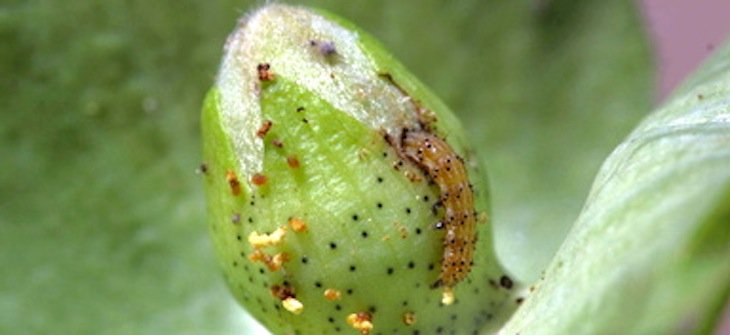Number of bollworms ‘decidedly higher’ in Arkansas, could hurt cotton crop
by July 23, 2018 1:26 pm 1,405 views

Arkansas cotton acres and prices are up in 2018, but an insect pest could eat into farmer profits. Bollworm populations are higher this year and are possibly more resistant to technologies meant to control them, according to the University of Arkansas System Division of Agriculture.
“The bollworm pressure is decidedly higher than what we’ve seen in the last couple years,” said Gus Lorenz, extension entomologist. “We’re seeing an extremely high number of eggs and moths in cotton fields. We’re kicking up hundreds and hundreds of moths in fields.”
Bollworms larvae cause damage to cotton bolls. The larvae, that eventually turn into moths, are more prevalent in the southern and central parts of the state. When those moths mature and begin to move, its called flight. The flights have been higher this growing season, without much of a break, Lorenz said.
“Flights have continued since June and haven’t let up,” Lorenz said. “We call these rolling populations, they just keep coming.”
Scientists are seeing indications that the bollworm problem could extend into northcentral and northeast Arkansas in the coming weeks, he said. The numbers of bollworms is concerning, but there’s another issue. Lorenz’s primary concern with this year’s bollworm pressure is the resistance to dual gene cotton recent data has shown. Dual gene technology refers to cotton varieties that have two Bt genes which are used to protect against multiple insect pests, including bollworm.
“Our concern is where we documented last year is the developing resistance to dual gene cotton,” Lorenz said. “We’re seeing more eggs and larvae developing in dual gene cotton, and it’s got us on edge.”
As far as management practices go, many Arkansas cotton producers have already taken control measures, but they’re getting hit again. Although there is a growing concern for the damage the pests can cause, Lorenz warns against going overboard with treatment applications.
“There are a lot of concerned growers that made an application seven to ten days ago of a diamide, like Prevathon or Besiege, to get the bollworms under control, but now there’s a new flight,” Lorenz said. “We’re advising growers to give it two weeks before making a second application of a diamide,” he said. “Usually residual control will last at least two weeks, maybe more. Those products are extremely expensive and I can’t see making a second application this soon. That could be a budget buster.”
Arkansas cotton producers are at risk with these current bollworm numbers, and Lorenz is warning farmers to scout their fields.
“Be diligent because this is a very critical time for cotton and soybeans,” Lorenz said. “Scout and scout hard. In the immediate future we will continue to see the development of bollworm populations.”
Cotton farmers are predicted to plant 480,000 acres this season, an 8% increase from last year, according to the federal National Agricultural Statistics Service (NASS). Cotton acreage had been in steady decline for more than a decade. Lower prices, higher input costs, the profitability of other crops and other factors led to the decline.
